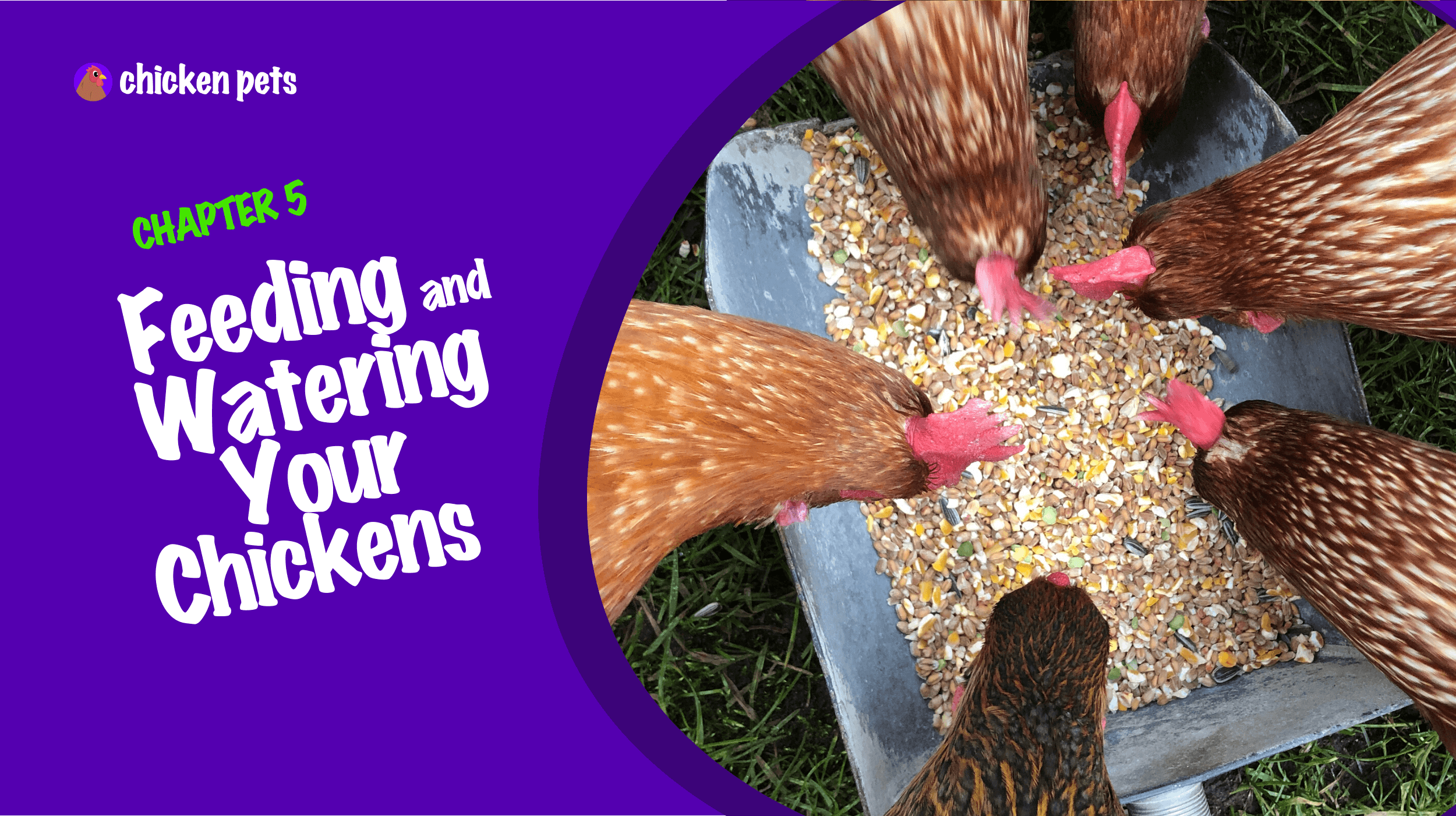Listen up, folks! You know the saying, ‘You are what you eat’? Well, it’s true not only for humans but also for our feathered friends, the backyard chickens. And, let’s not forget, we eat their eggs too, so technically, we are also what they eat. Mind blown, right?
Balanced Chicken Nutrition 101

Now, let’s get down to business. A balanced diet is the easiest way to ensure our chickens are living their best life, laying the tastiest eggs, and not scratching around for scraps. And guess what? It’s super simple! Just give them some good ole commercial feed made especially for them.
According to the Merck Veterinary Manual, these birds need a healthy dose of at least 38 different nutrients to thrive and lay eggs like bosses. So, ensuring they’re getting a balanced diet is crucial.
Now, a little birdie told me that chickens are pretty savvy when it comes to eating. They know precisely what they need and will adjust their food intake accordingly, but factors like the environment, stress, and the freshness of their feed can still affect their food intake and the nutrients consumed.
In addition to the commercial feed, giving them some greens and veggies is a good idea. These birds love their greens, especially grass, kale, broccoli, collards, and even weeds like clover and dandelion. If you can’t free-range them, bring the greens to them, and they’ll repay you with nutritionally superior eggs.
And, speaking of molting, these birds shed their old feathers and grow shiny new ones. Growing feathers takes a lot of protein, so giving them a little protein boost in the form of grubs, mealworms, or sunflower seeds can help. Don’t overdo it – we don’t want them to become bodybuilders. A feed formula with 18 to 20 percent protein can also do the trick.
Lastly, a word of caution – any supplements you give them can disrupt the balance of their diet. Too much scratch or table scraps—like bread products—can provide them with too much energy in carbs and fat, and they’ll end up eating less protein and other vital nutrients. It’s like giving kids too much candy – they won’t eat their veggies. So, let’s keep it balanced, folks!
All About Chicken Feed: Feasting like a Chicken King (or Queen!)
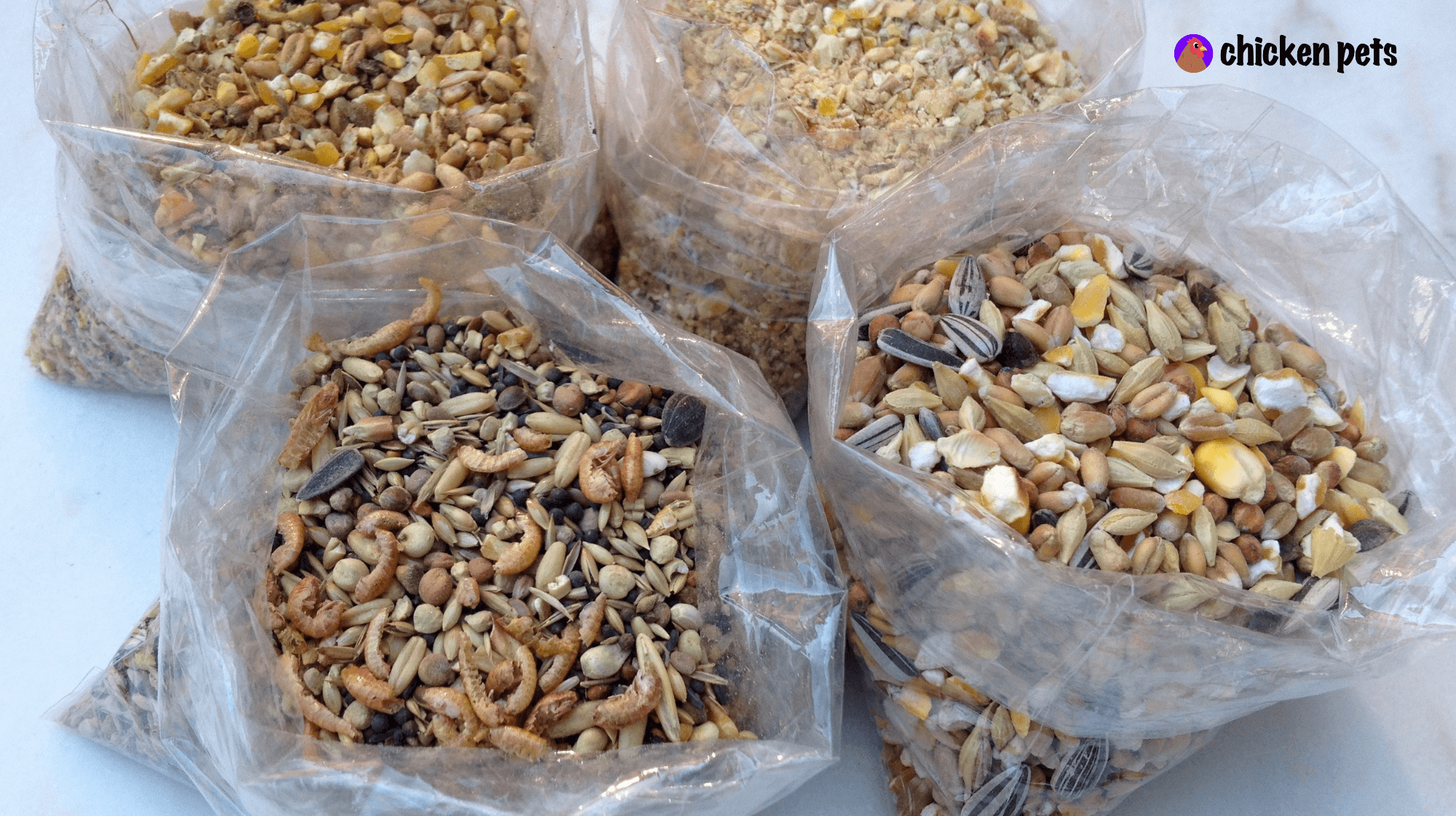
Every backyard chicken owner knows feeding their feathered friends is crucial to caring for them. So, let’s dive into everything you need to chow down on delicious chicken feed!
How Much to Feed a Chicken
Each chicken is unique, and their appetite can vary, but as a general rule, a laying hen will eat around 1/4 to 1/3 of a pound of feed per day. Remember that this will change based on their age, size, and other factors like weather conditions. But don’t worry. Your chickens will let you know when they’re hungry. Just listen for the loud clucking and squawking!
Types of Chicken Feed
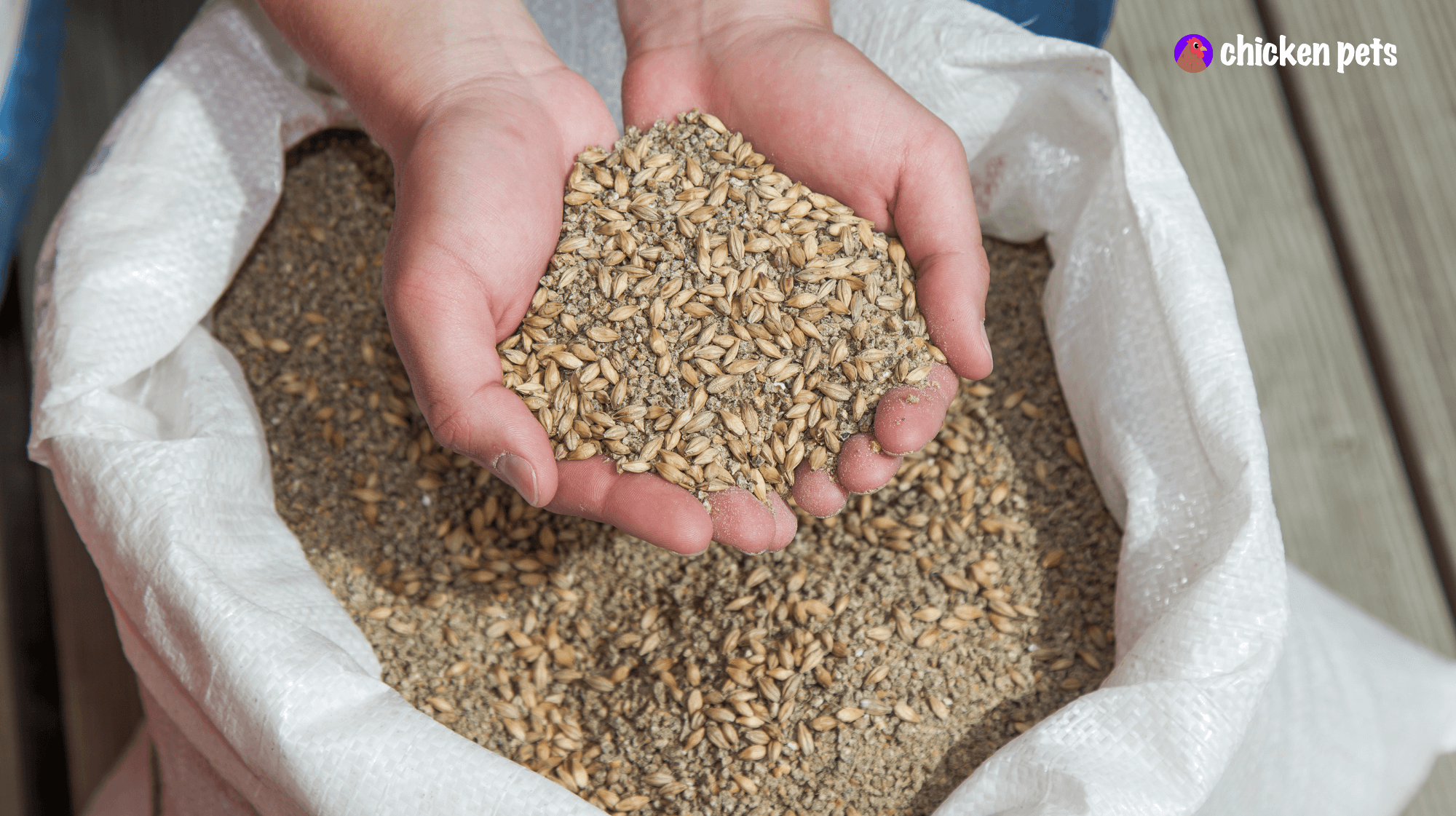
Like humans, chickens have different dietary needs at various stages of their life. Here are some of the most common types of feed:
- Chicken Starter — For newly hatched chicks
- Grower — For young birds up to 16 weeks old
- Chick Starter/Grower — A combination of the two above
- Layer — For hens that lay eggs
- Finisher or Broiler — For meat birds
- Scratch — A mix of grains like corn, oats, and barley for extra peck-o-tainment
Forms of Chicken Feed
The type of feed you choose is just one part of the equation. You also need to consider the form. The three most common forms are:
- Mash — A moist and easily digestible form of feed
- Crumble — A drier form of feed, perfect for picky eaters
- Pellets — A compact and convenient form that’s great for storage
- Whole Grain — For those chickens who love a little extra crunch in their diet
Fermenting the Feed
Fermenting chicken feed is where you soak it in water for several hours to help increase its nutritional value. Not only is it better for your chickens, but it’s also more cost-effective. Like us, chickens love a good soak, especially after a long day of scratching and pecking!
Where to Get the Feed
You can find the chicken feed at your local feed store or pet store or even order it online. Choose a reputable brand with a balanced blend of nutrients appropriate for your chickens’ needs.
WE RECOMMEND

10lb Chicken Feeder
We highly recommend this chicken feeder! It's easy to fill and clean, rainproof, and accommodates larger flocks with four ports. It's a lifelong feeder that grows with your flock, and with its port design, you won't have to worry about wasted food. Give your chickens the gift of this feeder today!
Feast for the Beaks — Grit & Calcium for Your Backyard Birds
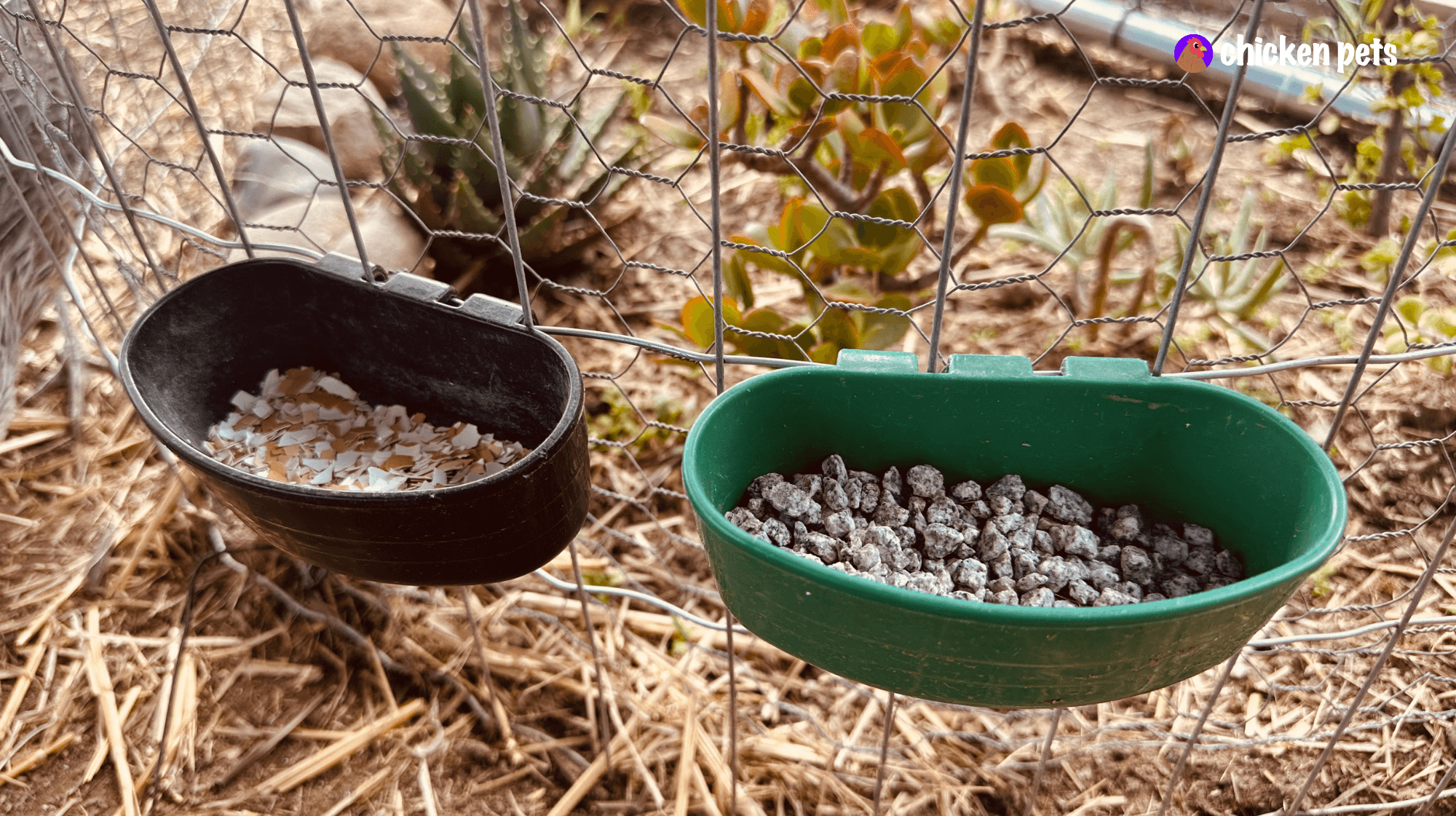
Welcome to backyard chicken-keeping, where the term “feast for the beaks” takes on a new meaning! Keep your feathered friends healthy and happy with the right mix of grit and calcium in their diets. Let’s start by taking a closer look at grit – it’s not just a rock-star-sounding word, but it also plays a crucial role in your chickens’ digestion. And then there’s calcium, the secret ingredient for strong shells and egg-cellent egg production. But beware! Don’t give the layering life to your non-laying birds, or you might end up with some egg-scruciating consequences. So, let’s get clucking and dive into the details!
Grit for the Grinders

Have you ever noticed your chickens gobbling up small rocks or pebbles? Well, they have a purpose! These little guys, known as grit, help your feathered friends grind up their food, as they don’t have teeth. This ensures that their digestion stays healthy and happy. If your chickens are confined and don’t have access to the great outdoors, you may need to provide them with some grit – which can easily be found at your local farm store.
Calcium for Strong Shells
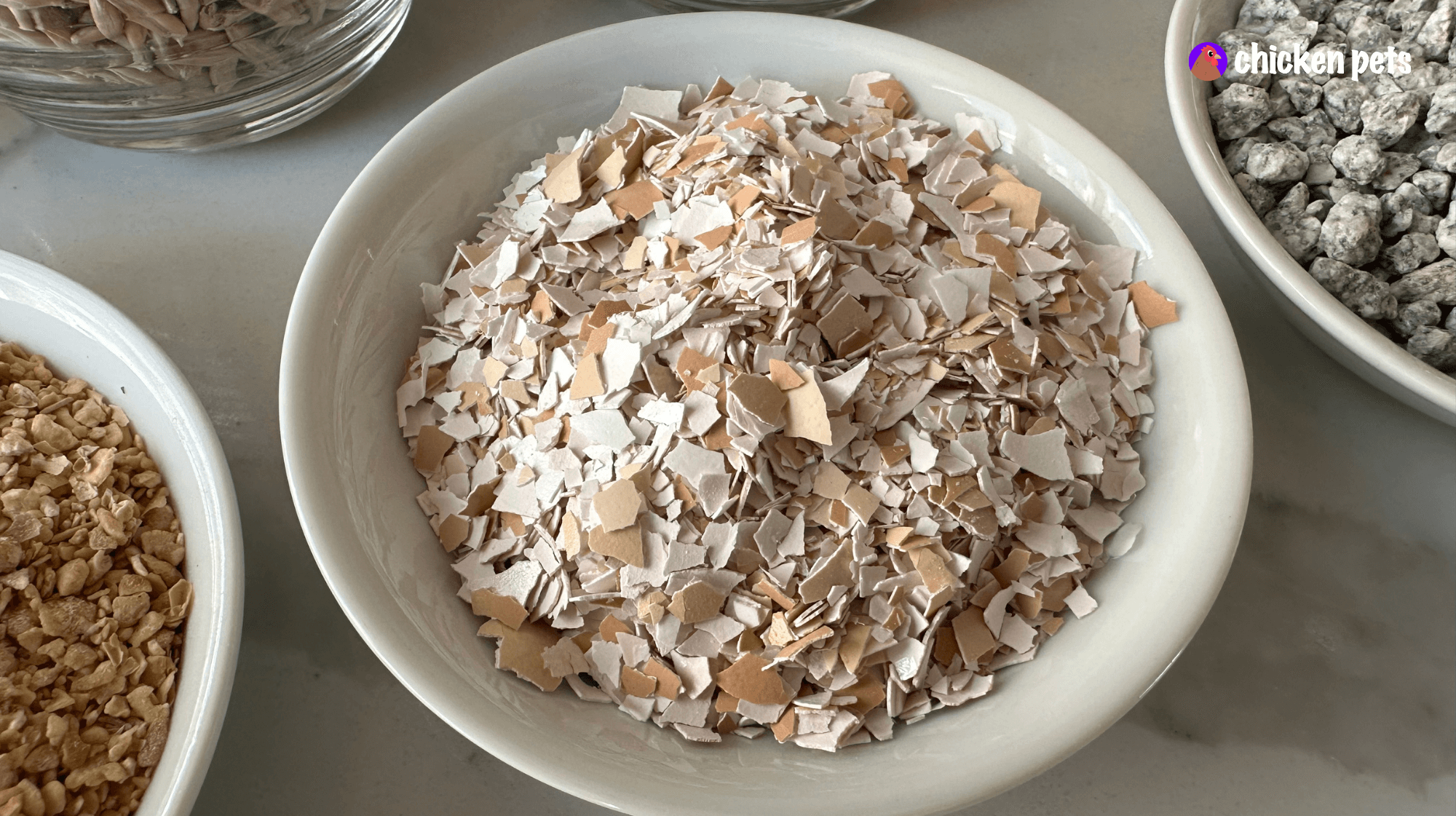
Buying feed for your laying hens will already contain the calcium they need for healthy bones and egg production. But, it’s always a good idea to offer extra calcium in the form of crushed oyster shells or eggshells, as some hens may need a little extra boost. These can be found at your neighborhood feed store.
Don’t Give Your Non-Layers the Layering Life
A tragedy you want to avoid is giving layer feed to your non-laying birds. These birds include young birds and roosters. If you provide them with layer feed, they’ll be getting excessive calcium, which can cause them harm.
Calcium is an essential nutrient for hens to produce eggs, but it’s not needed in the exact quantities for young birds or roosters. Too much calcium can cause serious health problems and affect the growth and development of your birds.
It’s always a good idea to double-check the type of feed you’re buying and make sure it’s suitable for your flock. If your birds are not layers, steer clear of layer feed, and opt for grower feed instead. This way, you can avoid unfortunate incidents and keep your feathered friends healthy and happy.
Funk it Up: The Scoop on Fermenting Chicken Feed
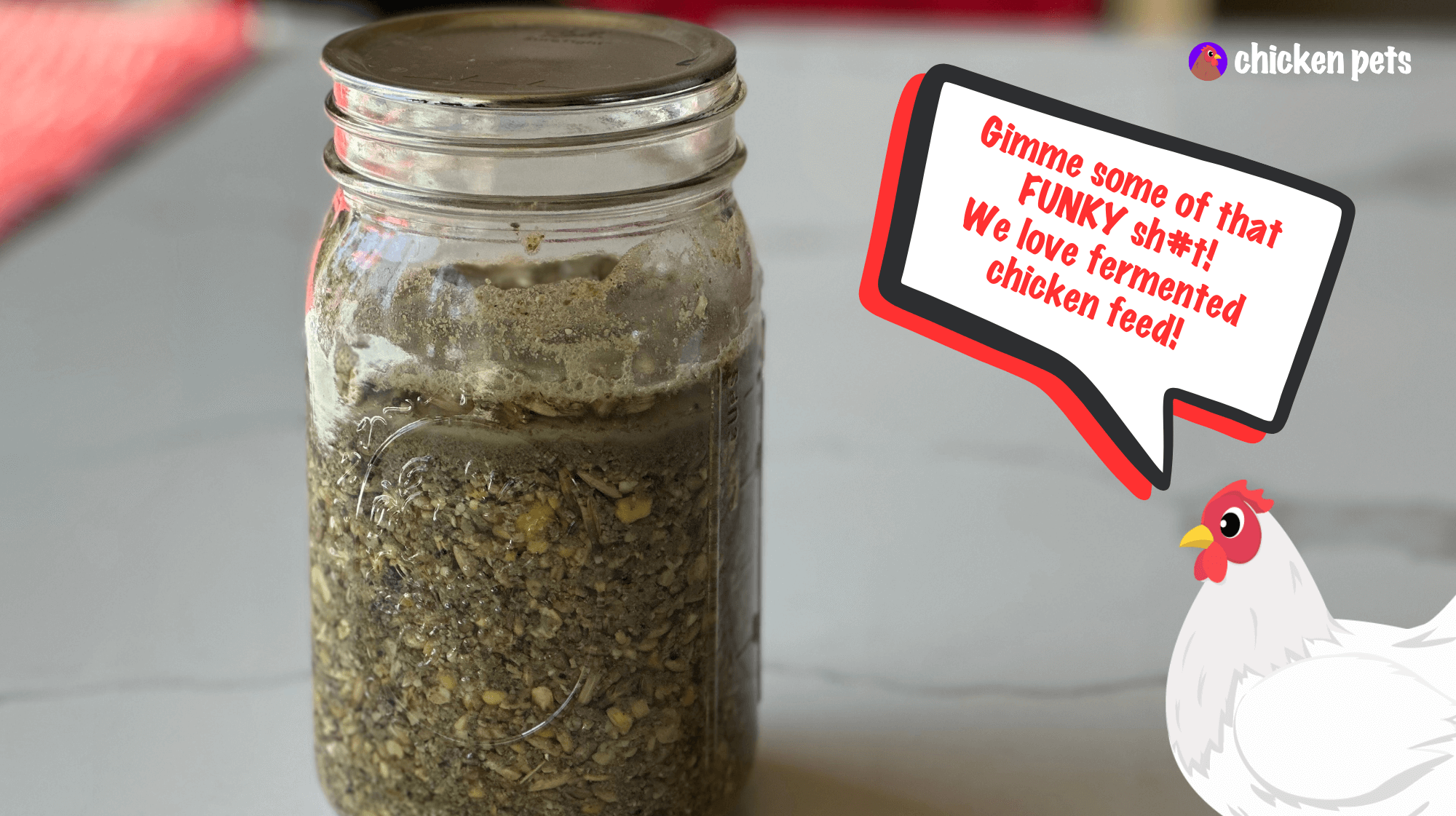
What is Fermented Feed? “Fermented feed” might sound like something you’d rather not give to your feathered friends, but fear not! This is a fancy way of saying the feed has been soaked in water for a certain time. The soaking allows the feed to break down, making it easier for your chickens to digest and increasing the nutritional value.
Why Ferment Chicken Feed?
Feasting on fermented feed isn’t just for the birds – it’s also for their overall health and well-being! From increased nutritional value to a happier gut, fermenting chicken feed has a lot of benefits for your backyard flock. This time-tested method of feeding chickens makes their food more digestible and enhances the nutrients they consume. And let’s not forget that making your fermented feed can be a cost-effective way to ensure your chickens get the best nutrition while keeping more green in your wallet. So, come and join the fermenting frenzy and discover the many benefits of this age-old tradition for your feathered friends.
- Increased Nutritional Value — Fermenting chicken feed breaks down the starches and carbohydrates, making it easier for your chickens to digest and unlocking more nutrients for their bodies to absorb.
- Improved Gut Health —By introducing beneficial bacteria and yeast, fermented feed helps maintain a healthy gut microbiome, essential for overall health and wellness in chickens.
- Better digestion —The fermentation process makes the feed more digestible, leading to better digestion and reduced waste.
- Cost-Effective —Fermenting chicken feed is a great way to save money and make your feed go further. Plus, you can control the ingredients, ensuring that your chickens get the best possible nutrition.
- Environmentally Friendly —By making your fermented feed, you can reduce the amount of food waste and packaging you generate, making it eco-friendly.
When to Ferment Feed?
Fermenting chicken feed is not just a trend but an intelligent way of ensuring your birds get the best nutrition possible. It’s an ideal choice for backyard chicken owners who want to save money, boost the nutritional value of the feed, and promote healthy gut bacteria in their birds. It’s also an excellent solution for those concerned about keeping their feed fresh, especially during the warm summer months when temperatures can cause the feed to spoil quickly. By fermenting the feed, you’ll slow the spoilage process, allowing you to keep your birds well-fed and healthy, no matter the season.
Fermenting Feed – The Funky, Fruity, and Flavorful Adventure
Fermenting chicken feed is a great way to add variety to your backyard birds’ diet. Not only does it offer a fun and creative cooking experience, but it also provides your chickens with essential nutrients that they might not otherwise receive. Here’s how to do it:
What You’ll Need:
- A glass, BPA-free plastic, or lead-free ceramic container
- Chicken feed or scratch
- Water
- (Optional) Apple cider vinegar as a starter
- A space to ferment (somewhere away from direct sunlight)
How to ferment chicken feed:
- Step 1: Fill ‘er Up — Place your chicken feed or scratch in the container and fill it with water, making sure to cover the grains with a few inches of water. The feed will expand, so add water as needed to submerge it. You can add some apple cider vinegar as a starter if you like, but it’s unnecessary. The feed and grains will contain natural bacteria and yeast that will kick off the fermentation process.
- Step 2: Get Your Fruit Fly On — Loosely cover the container and place it in an area that’s not too warm or cold. Remember that fermenting feed can attract fruit flies, so choose your location wisely. Some people like to ferment in large batches and keep the container outside, but not in direct sunlight.
- Step 3: Wait for the Magic to Happen — The feed will ferment over the next two to four days. The time will depend on the temperature, with warmer temperatures speeding up the process and cooler temperatures slowing it down. The liquid will get cloudy and develop bubbles, and a white substance will float to the top. This white stuff is kahm yeast and is not harmful. The ferment will also start to smell sour, like sourdough bread.
- Step 4: When It’s Ready to Eat — After two to five days, you’ll know the feed is ready when you can smell its sour scent. Drain off the liquid and give the feed to your chickens. Keep a little of the liquid to use as a starter in your next batch, which will ferment more quickly.
- Step 5: When to Toss It — If you notice mold growing on the feed, don’t feed it to your chickens. Toss it in the compost and start over. The fermented feed can be stored for a little while under the right conditions, but it’s best to feed it to your chickens within a week, or it might start to smell and taste funky.
So there you have it – the art of fermenting chicken feed! Give it a try, and let the fun and flavor begin!
Watering Your Chickens: Keeping Their Thirst Quenched
As any backyard chicken owner knows, a chicken’s thirst is unquenchable. Well, almost. But it’s essential to ensure they’re adequately hydrated to lay those eggs without a hitch! Here’s what you need to know about watering your feathered friends:
On average, a chicken can drink between one-half to one pint of water per day, depending on the bird’s age, size, diet, and environmental factors such as temperature and humidity. However, ensuring chickens have access to clean water is vital, especially during hot weather when they may drink more.
Watering Systems and Containers

When it comes to watering your chickens, there’s no one-size-fits-all solution. You can use anything from a simple bowl to a fancy, automatic watering system. But the key is finding what works for you and your flock. If you’re like me, you probably tend to over-complicate things, so I recommend starting simple and upgrading as needed.
Keeping Water Clean and Free of Contamination
No one wants to drink murky, contaminated water; your chickens are no exception. So, change their water regularly and clean their containers frequently. And, just in case your chickens are notorious water spillers, keep their watering area clean and dry. Trust me, a clean coop is a happy coop!
Providing Enough Water for the Size and Number of Chickens
It’s important to remember that the amount of water your chickens need depends on the number of birds in your flock and the temperature. In hot weather, they’ll need more water to stay hydrated. And, if you have a lot of chickens, you’ll need a larger container to accommodate their thirst. So, don’t be stingy with the H2O!
Tips and Best Practices for Watering Your Chickens
Here are a few tips and best practices to keep in mind when watering your feathered friends:
- Make sure their water is always accessible
- Keep their water in a shaded area to prevent it from getting too hot in the sun
- Avoid using metal containers, as they can get too hot in the sun and affect the taste of the water
- Don’t forget to add some ice on hot days to keep the water cool
- And, last but not least, don’t forget to add a dash of personality to their watering area. After all, a little flair never hurt anyone (or any chicken).
And so it goes! A comprehensive guide to keeping your chickens hydrated and happy. Remember, a hydrated chicken is productive, so keep their thirst quenched and watch those eggs roll in!
WE RECOMMEND

Chicken Waterer (2 gallons)
If you're looking for a reliable and easy-to-use waterer for your chickens, look no further than the RentACoop 2 Gallon Red Cup Waterer! As chicken enthusiasts ourselves, we've been using this waterer for our own flock and we absolutely love it.
Treat Time: The Dos and Don’ts of Treating Your Chickens
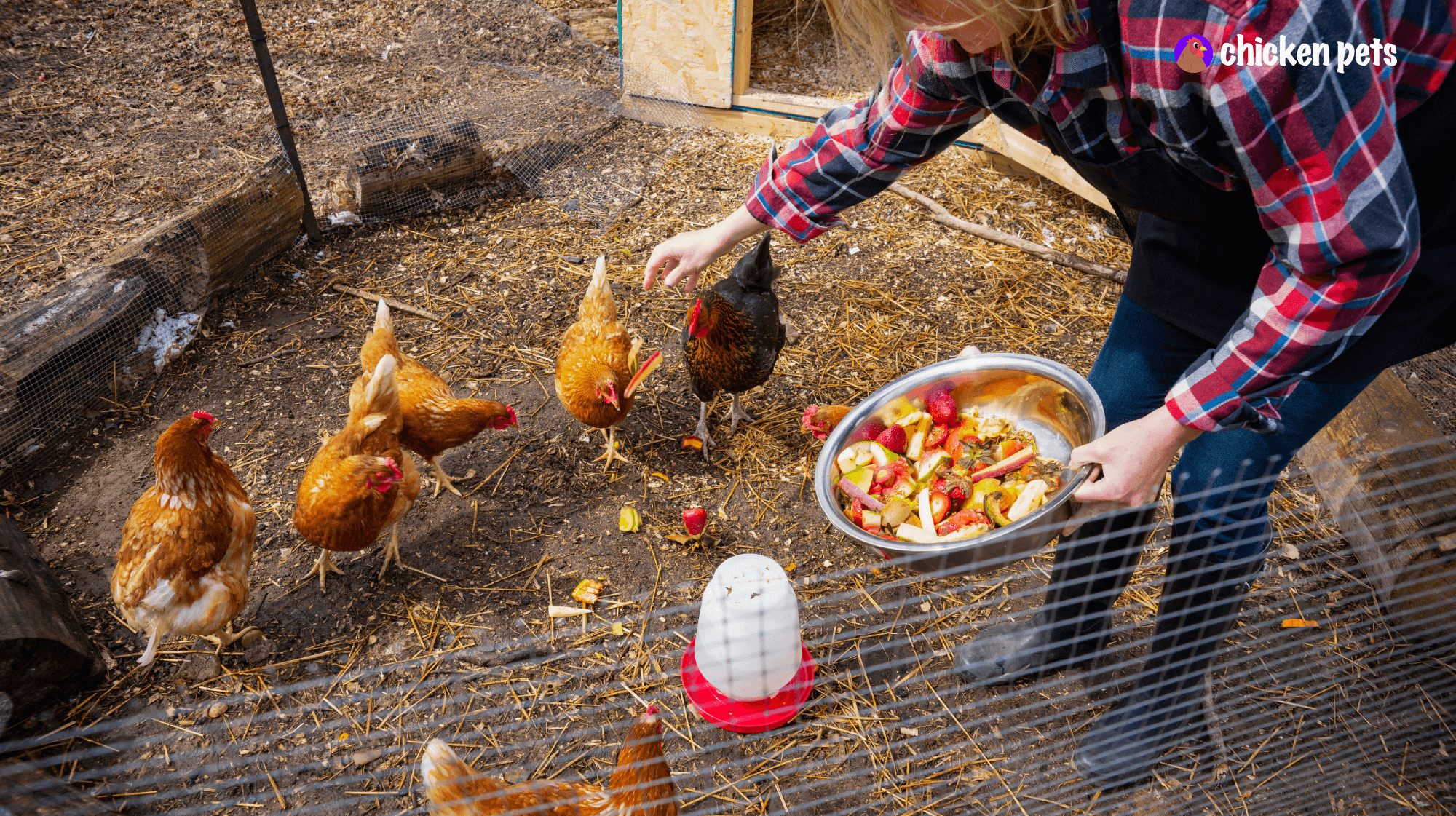
Let’s be real. Who doesn’t love treating their feathered friends? But before you go scattering scraps willy-nilly, there are a few things you need to know to keep your chickens healthy and happy. Here’s a rundown of what to feed (and what to avoid) when it comes to treats, scraps, scratch, and even human food.
Treats: The Good, the Bad, and the Cluckin’ Ugly
Treats can be fun to spoil your chickens and add excitement to their diet, but not all treats are created equal. Here’s a quick rundown of what’s safe to feed your birds and what you should avoid:
Good Treats:
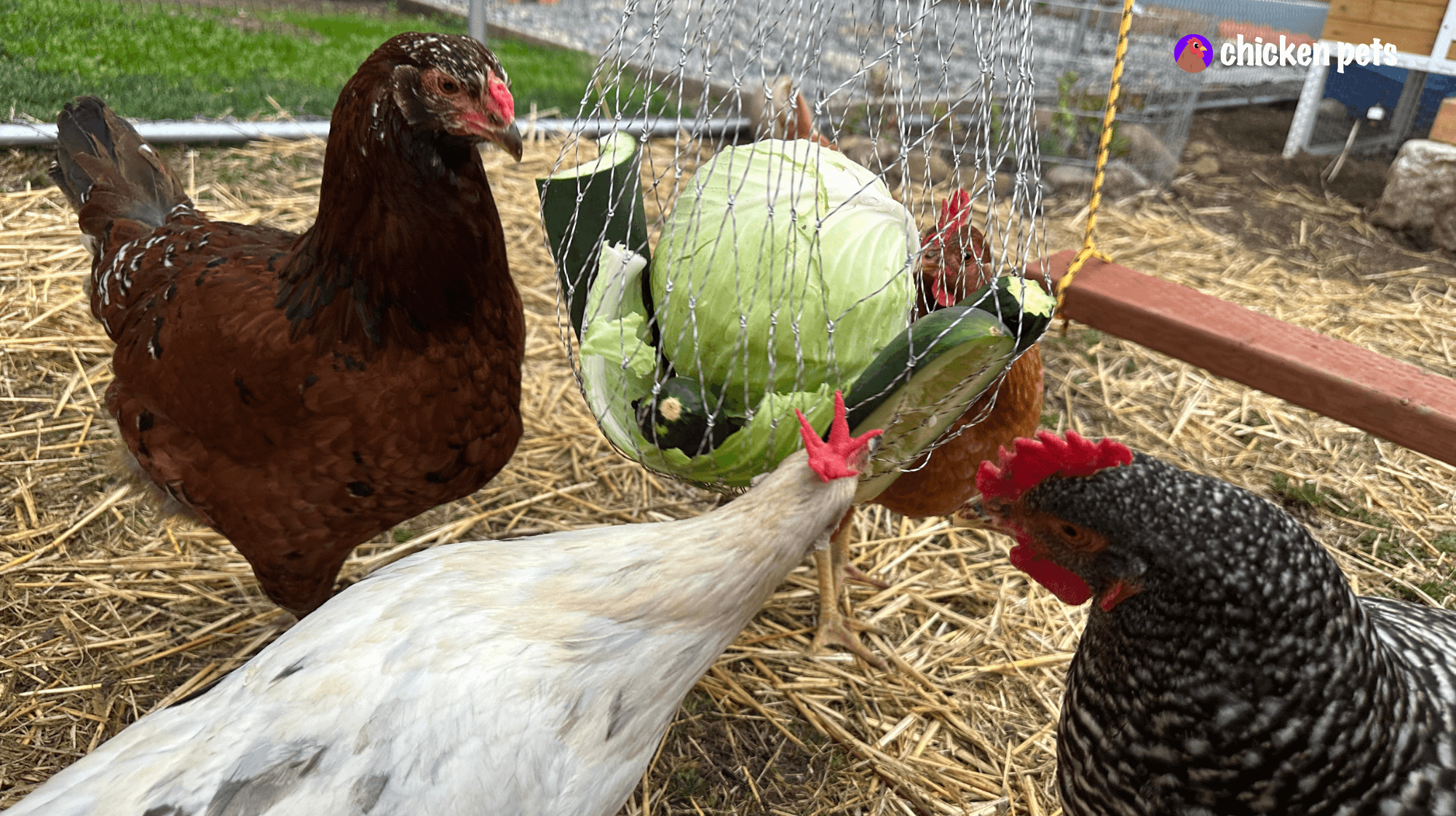
- Vegetables — Chickens love a good veggie snack, especially dark, leafy greens like kale and spinach.
- Fruits — Apples, berries, and grapes are all great options. Just be sure to chop them into bite-sized pieces to avoid choking hazards.
- Mealworms — These high-protein treats are a favorite among chickens.
- Crushed eggshells — This calcium-rich treat is essential for egg-laying hens.
Bad Treats:
- Avocado — This popular fruit contains a toxin called persin that can harm birds.
- Chocolate — Another no-no, as chocolate contains theobromine, which can be toxic to chickens.
- Onions and garlic — While these flavorful foods are great for us, they can cause digestive issues for chickens.
Cluckin’ Ugly Treats:
- Anything moldy — Moldy food can harm chickens, so always avoid feeding them anything that’s gone bad.
WE RECOMMEND

Hanging Feeder Net for Chicken Treats
As chicken owners, we highly recommend this bird treat holder! We've been using it and absolutely love it. Fill it with fruit, vegetables, and treats and your chickens will love it!
Scraps and Scratch: The Thrifty Treats
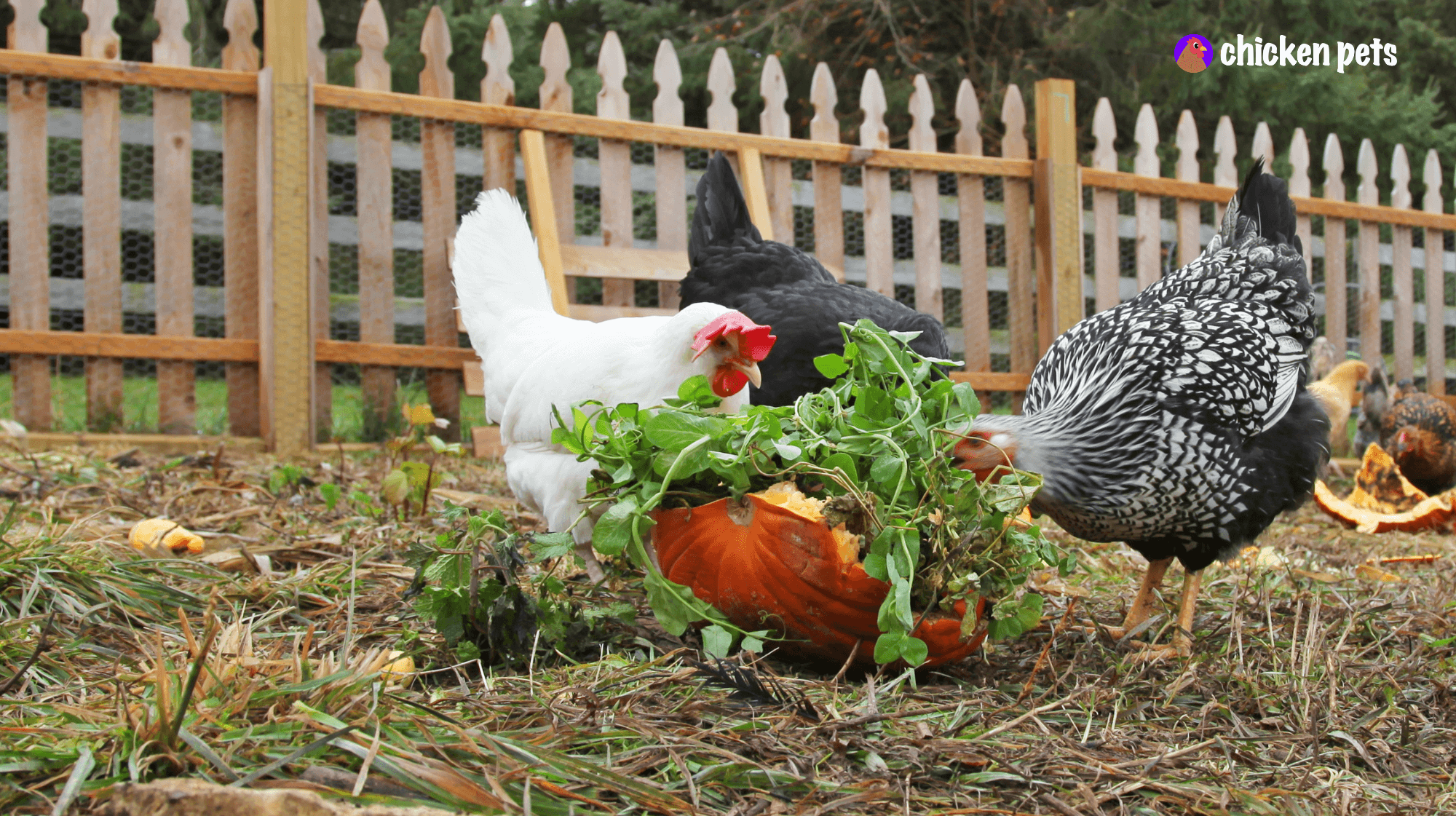
Scraps and scratch are a great way to supplement your chickens’ diet and save money. Just be sure to avoid feeding your birds anything moldy, greasy, or spoiled. Here are a few scraps that are safe and nutritious for chickens:
- Vegetable scraps — Carrot tops, lettuce leaves, and other veggie scraps are a great way to treat your birds while reducing food waste.
- Grains — Chickens love grains like oats, corn, and barley, so consider saving your breakfast leftovers for them.
- Bread — Chickens will happily chow down on stale bread, but be careful not to feed them too much, as it’s high in carbohydrates.
Human Food: A Treat or a Temptation?
Chickens love a good snack, just like humans do. However, knowing what treats are safe for them and what to avoid is essential. Feeding them the wrong foods can negatively affect their health and well-being. So, let’s dive into what’s okay to share and what’s best left off the menu.
Safe Treats for Your Feathered Friends
- Cooked pasta and rice — These tasty leftovers are a great way to supplement your birds’ diet and reduce food waste. And who knows, maybe they’ll even give you a crowing “thank you” for the delicious meal.
- Peanut butter — Chickens go nuts for peanut butter’s creamy, nutty flavor. Just be sure to avoid feeding them anything with sugar or salt added, as too much of these ingredients can upset their delicate tummies.
Tempting but Dangerous Treats
- Processed foods — Chickens shouldn’t eat junk food like humans, and High-fat, high-salt, and highly processed foods can harm them. So, avoid feeding them anything from a bag or a can, and stick to wholesome, natural treats.
- Meat and dairy products — These foods can attract unwanted guests, like rodents and other pests, to your coop. Plus, they can cause digestive issues for your birds. So, it’s best to avoid feeding them meat and dairy.
Regarding treats for your chickens, stick to the safe options and say “no” to any tempting but dangerous treats. Your birds will thank you for the nutritious and delicious treats, and you’ll know that you’re keeping them healthy and happy.
WE RECOMMEND
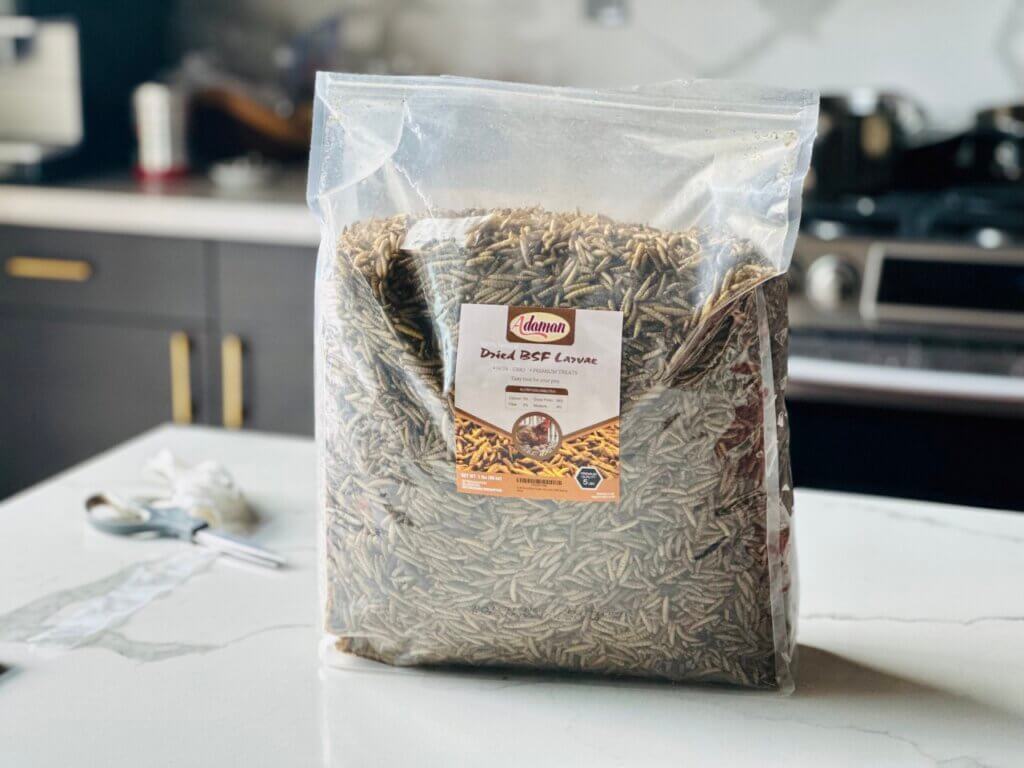
Black Soldier Fly Larvae
Your chickens will go wild for Adaman Dried Black Soldier Fly Larvae! Our chickens LOVE it! This 100% natural, non-GMO chicken food is packed with up to 45% crude protein and 85x more calcium than dried mealworms. It's sustainable, natural, and easy to use - simply toss it on the ground or use it as a topping.
Don’t Let Your Chickens Get a Taste of These Toxic Treats
When feeding your feathered friends, knowing what’s safe and what’s not is essential. Unfortunately, many foods can be toxic to chickens and cause serious health problems or even death. So, let’s ensure your birds never suffer the consequences of a bad snack choice.
Foods to Avoid
- Avocado — All parts of the avocado plant are toxic to chickens, so keep them away from your birds.
- Chocolate and Caffeine — The caffeine and theobromine found in chocolate can be toxic to chickens, so keep it away from them.
- Alcohol — Keep your chickens away from drinks and let them stay sober. Alcohol can be toxic to them.
- Onions and Garlic —While they may add flavor to your cooking, they can be toxic to chickens and cause digestive problems.
- Rhubarb — The leaves of this plant contain oxalic acid, which is toxic to chickens. So, if you have a rhubarb plant in your garden, keep your birds away.
- Potatoes — Raw or sprouted potatoes contain solanine, which is toxic to chickens. So, make sure to cook potatoes before feeding them to your birds.
- Raw Beans — Raw beans contain lectins, which can be toxic to chickens. So, make sure to cook beans before feeding them.
- Moldy Food — Moldy food can contain mycotoxins, which can be toxic to chickens. So, keeping their feed dry and free of mold is essential.
Plants and Weeds to Avoid
When keeping your feathered friends safe, it’s essential to be mindful of the plants and weeds they come into contact with. Chickens may have an innate sense of what they can and cannot eat, but it’s always best to err on the side of caution. Some plants, such as nightshade plants (e.g., tomatoes, potatoes, peppers, and eggplants), chrysanthemums, daffodils, delphiniums, foxgloves, hyacinths, larkspur, lily of the valley, rhododendrons, and yew, can be toxic to chickens and should be avoided. The rhubarb leaves, as mentioned previously, also contain poisonous substances and should be kept away from your birds.
In general, it’s best to stick to a balanced and well-rounded diet for your chickens rather than relying on scraps and treats. Avoiding these toxic foods will keep your chickens healthy and happy for years.
A Word of Caution
While these foods should be avoided, keeping an eye on your birds and monitoring their behavior and health is always a good idea. Contact a veterinarian immediately if you suspect your birds have ingested something toxic.
Now that you know what to keep away from your birds, it’s time to stock up on some safe and tasty treats for them. Happy feeding!
The article is a chapter from our book. Keep reading the chapters below.

- Backyard Chickens: The Beginners Guide
- Chapter 1: Raising Chickens in Your Backyard. Pros, Cons, Costs
- Chapter 2: Chicken Coops. Components, Buying, Building
- Chapter 3: Chicken Breeds for Beginners. Where to Start
- Chapter 4: Baby Chicks. Everything You Need to Know
- Chapter 5: Feeding and Watering Chickens Ultimate Guide
- Chapter 6: Chicken Health and Hygiene: The Master Guide
- Chapter 7: Chicken Eggs. The Incredible Edible Egg!
- Chapter 8: Chicken Psychology and Behaviors
- Chapter 9: Chicken Shit. Quality, Consistency, Color, Smell

